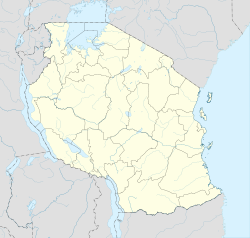
- Pressure: 1012 hPa
- Humidity: 83 %
- Clounds: 100%
- overcast clouds
Please tell us which country and city you'd like to see the weather in.
| Pangani | |
|---|---|
| — Town — | |
| Pangani Town | |
|
|
|
| Coordinates: 5°24′S 38°59′E / 5.4°S 38.983°E | |
| Country | |
| Region | Tanga Region |
| District | Pangani District |
| Population | |
| • Total | 8,000 |
| Time zone | EAT (UTC+3) |
| Area code(s) | 027 |
| Website | tanga.go.tz |
Pangani is a town in northeast Tanzania that lies 45 km south of Tanga, at the mouth of the Pangani River. It is the headquarters of Pangani District.
Although archaeologists have found the remains of small 15th century settlements on the bluffs just north of Pangani, the modern town came to prominence in the nineteenth century, when, under nominal Zanzibari rule, it was a major terminus of caravan routes to the deep interior. From the 1860s onward townspeople established large plantations of sugar and coconut in Mauya, along the banks of the river just west of town. The plantations were worked by slave labor, and Pangani also became an important center of the slave trade, shipping captives taken in the wars attendant on the collapse of the Shambaa kingdom in the Usambara mountains to the plantations of Pemba and Zanzibar. After the Sultan of Zanzibar signed treaties with Great Britain outlawing the ocean-going trade in slaves in 1873, Pangani became a center for smuggling slaves across the narrow channel to Pemba, in evasion of British warships.
In 1888, Pangani was the center of an armed movement to resist German colonial conquest of the entire mainland Tanzanian coast. The local leader of the resistance was Abushiri ibn Salim al-Harthi, a Swahili-speaker born in Zanzibar who owned a small estate at the suburb that now bears his name. Abushiri was instrumental in coordinating resistance to German conquest along much of the coast. The Germans hanged him at Pangani in December 1889.
Several historical sites in and around the town serve as reminders of the strong Arabic influence and the later German and British colonial era in Tanganyika. The district boma or headquarters is the most impressive building remaining from the period of Zanzibari rule.
The Mauya plantations no longer grow sugar, but produce much coconut and betel-nut. Pangani was once a secondary center of the sisal industry, servicing sisal plantations to the north and south of town. Pangani also has a fishing industry. In recent years beach resorts north and south of the town have brought tourists. The town is a district headquarters. Its hospital draws patients from many parts of the region. Funguni Secondary School is in Pangani Town and Boza Secondary School is a short distance north.
Sources [link]
- R.M. Gramly, "Archaeological reconnaissance at Pangani Bay," Tanzania Notes and Records, 86/87 (1981), 17-28.
Jonathon Glassman, Feasts and Riot: Revelry, Rebellion, and Popular Consciousness on the Swahili Coast, 1856-1888 (Portsmouth: Heinemann; Dar es Salaam: Mkuki na Nyota; Nairobi: EAEP, 1995).
References [link]
| Wikimedia Commons has media related to: Category:Pangani |
https://wn.com/Pangani

Pangani River
The Pangani River (pin-gi'nee) (also called Luffu and Jipe Ruvu, especially in older sources, and probably once called Rhaptus) is a major river of northeastern Tanzania. It has two main sources: the Ruvu, which rises as Lumi at Kilimanjaro, passes through Lake Jipe, and empties into the Nyumba ya Mungu Reservoir, and the Kikuletwa, coming from the west and mainly fed by Mount Meru, which also enters into the Nyumba ya Mungu Reservoir. Just after leaving the reservoir the stream becomes the Pangani, which empties into the Indian Ocean at the town of Pangani.
For much of its length the river flows along the regional borders of Kilimanjaro Region and Manyara Region, before flowing into Tanga Region, which contains the 68 MW Pangani Power Station and the Pangani Falls Dam. There are several inhabited islands within the river. The river is full of crocodiles; hippopotami are scarcer in its lower parts.
Etymology
A main source of Pangani originates on Kilimanjaro, where it is the River Lumi. Lake Jipe may be considered a backwater of the Lumi. Below Lake Jipe and above the falls, the river is referred to as "Ruvu". By the time it reaches the ocean at Pangani, it is referred to as the Pangani River.
Podcasts:
Bangun
by: A.c.a.bCuba renungkan hari ke hari
MALAPETAKA DI SANA SINI
bENCANA DATANG DAN JUGA PERGI
Tapi pastikan kembali lagi
Kita masih di awang awangan
Berkhayal dengan kemewahan
hasil usaha peninggalan
Mereka yang telah kita lupakan
Entah apa yang akan terjadi
Bila bencana melanda nanti
Tiada siapa yang peduli
Dalam hidup kita hari ini
Jangan nanti di suatu hari
Menyalahkan sesama sendiri
Bila merdeka tiada erti
Sesalan tiada berguna lagi...
Jangan mudah engkau berkata
Dunia hanya sementara
Untuk kau mundur dan leka
buat selama-lamanya
Jangan nanti di suatu hari
Menyesali apa yang terjadi
Kerana engkau masih bermimipi
Di siang hari...
Bangun..dari tidur



